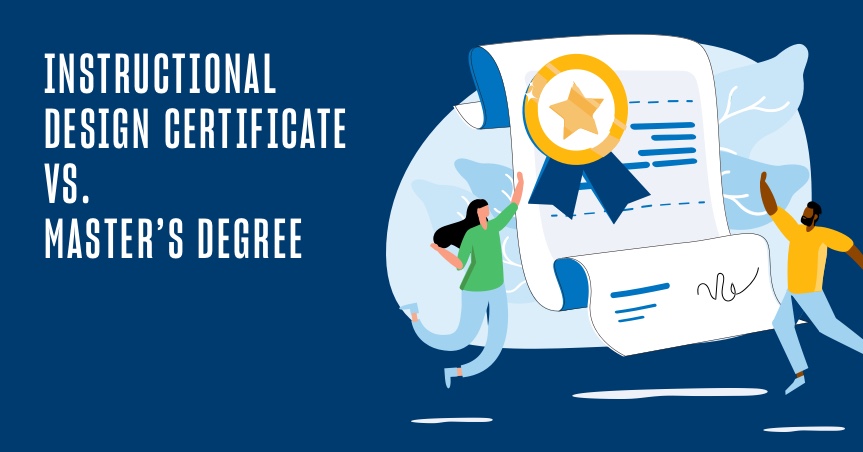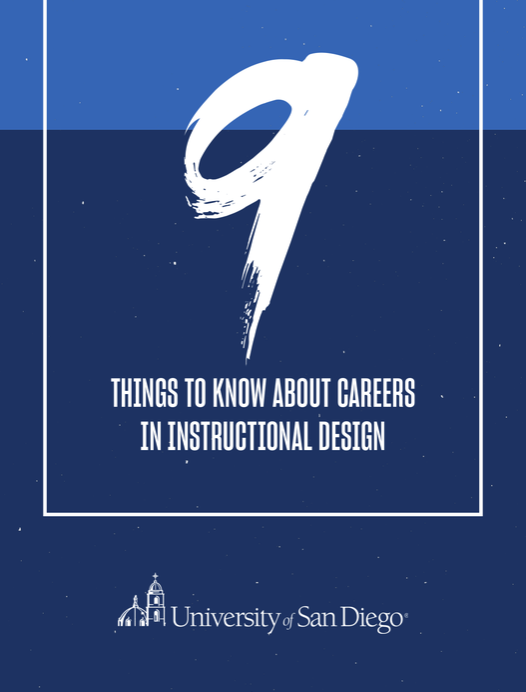Instructional design, also referred to as learning design, is one of the more popular career choices for those looking to work in higher education or corporate settings. Professionals who are interested in becoming instructional designers (IDs) or learning designers (LDs) will find a lot of opportunities, but also a lot of competition as more people enter the field.
To excel in this profession, IDs should be able to showcase an understanding of various ID models and the science of how people learn. Instructional design certificate programs and master’s degree programs can both provide specialized knowledge on these topics, along with important hands-on experience in course design, as well as the opportunity to use popular learning technologies and eLearning authoring tools. But which option meets your current needs and is better for your career goals?
Here’s how instructional design certificates differ from master’s degrees in instructional and learning design — in their requirements, level of instruction and the ways they can benefit your career.
What Is an Instructional Design Certificate?
An instructional design certificate is a graduate or professional certificate that participants receive upon completion of an educational program. Certificate programs are much shorter than other post-graduate tracks, typically the equivalent of taking 4–8 graduate courses. As a result, you can expect to earn a certificate in less time and at a lower cost than a degree.
Certificate programs tend to focus on teaching specific skills, mastering certain programs, or working in select areas. For example, an ID certificate program about eLearning design would teach skills on how to design for a digital environment, but not necessarily touch on other topics like establishing learning goals and measuring learning outcomes.
[FREE GUIDE] Is a certificate program is enough? Explore how instructional design education can fuel your career growth.
What Is an Instructional Design Master’s Degree?
An ID master’s degree is awarded as a Master of Science in Instructional Design (or Learning Design) or a Master of Education. Full-time master’s programs usually take two years to complete, though accelerated or online programs can be shorter (some even fewer than 12 months).
Master’s degree programs cover a wider breadth of subjects, including fundamental theories and concepts related to instructional design. Comprehensive master’s degree programs will also ask students to apply those concepts to “real-world” scenarios, either in-class or for capstone projects, to produce a portfolio of work.
Instructional Design Certificate vs. Master’s Degree in Instructional Design
Beyond those basic differences, consider the following nuances and benefits when thinking of applying for either a graduate certificate program or a master’s degree program.
Instructional Design Graduate Certificates:
- Have less restrictive requirements for acceptance, making them easier to apply to and get into than a master’s program.
- Are not a substitute for a bachelor’s degree, so won’t make you eligible for positions that require a bachelor’s in education or bachelor of science in instructional design.
- Can provide as an introductory education to the material, focusing on a “surface level” understanding of theories and concepts. If you’re unsure about this field and are looking for an opportunity to see if it’s the right fit without making a large commitment of time and money, this could be a good option.
- Can offer the opportunity to learn specific software, instructional techniques, and learning design best practices. This would be suitable for educators who are looking to switch their careers to the field of instructional design or for experienced IDs who want to familiarize themselves with new technology.
- Can also offer focused instruction on specific ID tools and techniques, allowing existing IDs and professional trainers to refine their instructional practices or expand their areas of expertise.
Instructional design graduate certificate programs provide some exposure to ID content and can serve as both professional development and a continuing education opportunity. Compared to a full-time graduate program, the certificate programs can be completed in a shorter timeframe and require a lower level of commitment.
Master’s Degree in Instructional Design Programs:
- Have a higher bar for entry than certificate programs, requiring a bachelor’s equivalent degree and, in some cases, additional professional experience.
- Can provide an advantage in the job market, especially for openings that specify “degree required, master’s preferred.” You may need a master’s degree for senior-level leadership positions at universities, corporations, and in government agencies.
- Are designed to provide a “deep dive” into instructional design theories and research about how people learn. Most programs will provide an opportunity to refine training and development techniques, as well as on-hands experience with industry standard course design software.
- Are great for experienced educators or trainers who want to transition into a full-time career as an instructional designer. The degree helps professionals who are doing the work of IDs and looking to further their careers move into leadership roles or positions where they can teach these concepts to others.
Committing to a full-time master’s program will require more time and effort than a certificate course in instructional design, though online programs offer more flexibility in time and scheduling. They are great options for those who are serious about making a career switch or advancing in their careers as instructional designers. The payoff is that compared to certificates, master’s programs provide:
- A broader knowledge base
- A deeper dive into specific topics
- Hands-on experience applying theory and best-practices
Advanced Education for Instructional Design
| Certificate | Master’s Degree | |
| Credit requirements | 4 – 12 | 30 – 40 |
| Average cost | $1,000 — $6,000 | $30,000 — $55,000 |
| Online learning options | Yes | Yes |
| Acceptance requirements | Few, if any | Bachelor’s degree |
| Level of instruction | Targeted | Comprehensive |
| Level of theory | Limited (depending on certificate program) | In-depth |
| Required for positions | No, though can shore up credentials | Yes, for some higher-level instructional and leadership positions |
How to Decide Which Is Best for Your Career Goals
Identifying your long- and short-term career goals will help determine which educational path is the right one. While certificates can help you learn targeted skills, a master’s program can give you an advantage in knowledge, skills, and starting salary if you want to become an instructional design professional.
A study on learning design degrees and certificates by The Learning Guild found that:
- At least half of all IDs interviewed had earned a master’s degree. Those with higher degrees earned more, as each degree equates to roughly an additional $3,000 per year in salary.
- A majority of employers, both in education and private industry, expect applicants to have at least a bachelor’s degree. Two sets of findings showed that 15% of job postings required a master’s degree in instructional design and 19% preferred a master’s degree in the learning and development field.
- Those IDs and LDs with master’s degrees felt that the degree helped them to be in a better position for promotions, assisted in their professional development, and allowed them to develop more effective ways of working.
For those with professional aspirations of becoming an instructional designer, having a master’s degree provides some clear advantages. However, not all programs are created equal. When looking at different degree or certificate programs, consider the following advice and questions to ask yourself:
Take the time to evaluate the programs you’re interested in. Most, if not all, programs will have their details listed on their website. Some things to ask yourself:
- Is the program online, and will it work with my schedule?
- What areas of study are covered?
- What learning technologies and software are included?
Beyond just self-advancement and personal development, what outcomes are you interested in? Some questions to consider include:
- Am I looking for ways to boost organizational performance and efficiency?
- Am I interested in finding ways to motivate personnel and enable individual success and advancement?
- Am I interested in teaching others about instructional design or taking a leadership position where I’ll need to oversee others?
You’ll need to consider if it’s worthwhile to invest in a master’s degree so you can leverage its specific advantages:
- Is it important that I’m more likely to get hired with a master’s degree?
- Is the prospect of faster advancement within my career important?
- How important is it to me to be able to start at a higher salary?
Alternatively, consider if you are better served by the specific instruction provided by certificate programs:
- Am I more interested in specific information about the ID field, rather than a comprehensive overview?
- Am I looking to enhance my existing credentials, or learn a whole new skillset?
- If I’m hoping for a career shift into instructional design, what will I need to learn to expand my existing knowledge and skills?
Finally, consider that this doesn’t have to be an “either/or” binary choice. Some master’s degree programs allow the transfer of credits from accredited certificate programs. Look into different programs that have articulation agreements with each other if you’re interested in keeping your options open.
[RELATED RESOURCE] Still not sure which is right for you? Learn how each option fits into instructional design careers.
Why You Should Earn Your Master’s Degree from USD
Are you ready to explore your possible future as a learning designer? If so, we welcome you to consider the University of San Diego’s Master of Science in Learning Design and Technology (LDT) degree.
USD’s Learning Design and Technology master’s degree program provides a comprehensive understanding of the science behind how people learn. In addition to teaching a deep understanding of ID theory and knowledge, our program will engage you in the leading technology tools currently used in instructional/learning design. As a part of the USD MS-LDT program, you’ll learn how to make learning experiences more engaging, as you work in a hands-on approach that turns theory into practice.
Plus, if you are a graduate of either the University of California Irvine’s (UCI) Division of Continuing Education or Oregon State University’s (OSU) Division of Continuing Education certificate programs, you can receive credit hours applied toward the LDT program. Provide that you have:
- Earned a grade of B or higher in each course of UCI’s E-Learning Instructional Design Certificate program, or
- Earned a “pass” grade in each of OSU’s E-Learning Instructional Design and Development Certificate courses,
Then you may be eligible to receive credit toward your USD’s Master’s of Science in Learning Design and Technology degree.
If you’re interested in becoming a professional instructional and learning designer, then consider USD LDT as the path for your career.




![Top 10 Instructional Design Careers [+ Salary Guide]](https://onlinedegrees.sandiego.edu/wp-content/uploads/2022/03/ldt_blog_top10idcareers-1024x576.png)
![Top Educational Technology Jobs to Consider [+Salary Info]](https://onlinedegrees.sandiego.edu/wp-content/uploads/2022/02/dt_blog_topedtechjobs-1024x576.png)